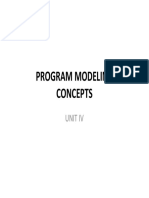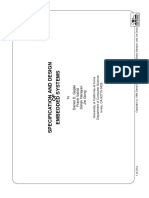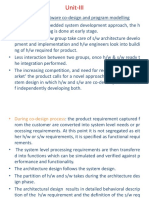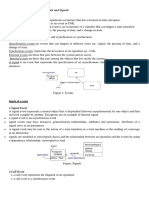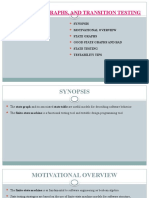DFG, FSM, Petri-Net, UML
Uploaded by
SHASHIKANTDFG, FSM, Petri-Net, UML
Uploaded by
SHASHIKANTi) Data Flow Graph (DFG):
The Data Flow Graph (DFG) model translates the data processing
requirements into a data flow graph.
The Data Flow Graph (DFG) is a data driven model in which the program
execution is determined by data. This model emphasizes on the data and
operations on the data which transforms the input data to output data.
Indeed DFG is a visual model in which the operation on the data (process) is
represented using a block (circle) and data flow is represented using arrows.
An inward arrow to the process (circle) represents input data and an outward
arrow from the process (circle) represents output data in DFG notation.
Embedded applications which are computational intensive and data driven are
modeled using the DFG model. DSP applications are typical examples for it.
Suppose one of the functions in our application contains the computational
requirement x=a+b; and y=x-c. Following figure shows the implementation of
a DFG model for implementing these requirements.
In a DFG model, a data path is the data flow path from input to output. A DFG
model is said to be acyclic DFG if it doesn't contain multiple values for the
input variable and multiple output values for a given set of inputs. A DFG
model translates the program as a single sequential process execution.
ii) FSM:
A finite state machine is a model of discrete behavior, which consists of: a
finite number of states, transitions between two of those states, and actions.
A state represents a certain behavior. A transition indicates a state change
and is guarded by a condition. An action is a description of an activity that is
to be performed.
If this action depends on the state, it’s called a Moore machine. If the action is
performed when a transition occurs, so when the state and condition are
satisfied, it’s called a Mealy machine. Most machines are both a Moore and
Mealy machine at the same time.
Some integrated development environments (IDE) allow a designer to draw a
FSM diagram on screen, and then the IDE automatically translates the
diagram into a software or FPGA or ASIC implementation. This allows the
designer to use a natural way of representation of the system.
iii) Petri-net:
Petri Net (PN) is an abstract model to show the interaction between
asynchronous processes. It is only one of the many ways to represent these
interactions.
Asynchronous means that the designer doesn't know when the processes
start and in which sequence they'll take place.
A common manner to visualize the concepts is with the use of places, tokens,
transitions and arcs.
We refer to the basics of Petri Net for a first introduction in notations. We want
to mention that a transition can only fire when there are tokens in every input-
place. When it fires, one token is taken from every input-place and every
output-place from the transition gets an (extra) token.
Places can play the following role of a geographical location or the
environment of a robot, i.e a place he has to go to. Tokens can be a physical
object: a robot. Transitions can be a transformation of an object: a robot which
changes his role.
In a PN, situations can occur where two or more systems wait for each other
before an action can take place. This is called a deadlock.
It can also occur that a single system has to wait forever at the beginning of a
transition because another process has always higher priority. This problem is
called starvation.
In the mathematical model a transition takes no time. In the real world
executing a transition takes some time and the sequence or timing of events
becomes important. This problem relates to race conditions or race hazards.
When the PN is rather big, these problems are hard to find.
iv) UML:
FSM is limited in a way. It cannot have two states active at the same moment,
next to each other.
The UML statechart is an attempt to overcome this limitation while retaining its
good features.
UML (Unified Modeling Language) is designed to specify, visualize, construct
and document software-intensive systems.
The essential syntax of statecharts is very much like FSM's.
In a statechart, it is possible that there are states within states, so there is a
kind of a hierarchical structure. They are called substates and superstates or
parentstates.
Another possibility is concurrent states. By using branching, a state can be
followed by more than one other state. Each transition can be guarded with its
own condition.
When more than one condition is satisfied, two states can be active at the
same moment.
Compared to FSM, the design of an embedded system can be visualized a lot
better and less complicated with sub- and superstates.
A good example to explain the usage of a statechart is a soda machine.
You might also like
- State Machine and Concurrent Process Model100% (1)State Machine and Concurrent Process Model52 pages
- Software Requirements Engineering Structural & Behavioural ModellingNo ratings yetSoftware Requirements Engineering Structural & Behavioural Modelling38 pages
- Specification and Design of Embedded Systems PDFNo ratings yetSpecification and Design of Embedded Systems PDF216 pages
- Specification and Design of Embedded Systems - Daniel D Gajski, Jie GongNo ratings yetSpecification and Design of Embedded Systems - Daniel D Gajski, Jie Gong216 pages
- Software engineering for embedded systemsNo ratings yetSoftware engineering for embedded systems82 pages
- Software For Embedded Systems Outline: - Models vs. Languages - State Machine ModelNo ratings yetSoftware For Embedded Systems Outline: - Models vs. Languages - State Machine Model13 pages
- FSM-based Specification Formalisms: Giovanni de MicheliNo ratings yetFSM-based Specification Formalisms: Giovanni de Micheli40 pages
- Unit I Part 2 Formalisms For System DesignNo ratings yetUnit I Part 2 Formalisms For System Design25 pages
- Advanced Microprocessors and Embedded Systems: Session: II Academic Year: 2008 - 09 Subject Code: 7EC 03No ratings yetAdvanced Microprocessors and Embedded Systems: Session: II Academic Year: 2008 - 09 Subject Code: 7EC 0337 pages
- Behaviour Modeling With State Machine and Activity DiagramsNo ratings yetBehaviour Modeling With State Machine and Activity Diagrams62 pages
- Software engineering for embedded systemsNo ratings yetSoftware engineering for embedded systems77 pages
- Embedded Systems Design With UML State MachinesNo ratings yetEmbedded Systems Design With UML State Machines25 pages
- Advanced Behavioral Modeling - states only - 1 hrNo ratings yetAdvanced Behavioral Modeling - states only - 1 hr34 pages
- Mastering_embedded_systems_with_UML_state_-_Nishimoto_TakehikoNo ratings yetMastering_embedded_systems_with_UML_state_-_Nishimoto_Takehiko362 pages
- Low Power VLSI Circuits and Systems Prof. Ajit Pal Department of Computer Science and Engineering Indian Institute of Technology, KharagpurNo ratings yetLow Power VLSI Circuits and Systems Prof. Ajit Pal Department of Computer Science and Engineering Indian Institute of Technology, Kharagpur22 pages
- 16 Statecharts and UML State Machine Diagrams: Learning ObjectivesNo ratings yet16 Statecharts and UML State Machine Diagrams: Learning Objectives2 pages
- Representing Embedded System Sequence Diagrams As A Formal LanguageNo ratings yetRepresenting Embedded System Sequence Diagrams As A Formal Language15 pages
- Install and Clsoe Activation When It Pops Up Automatically. - Replace File Here: C:/Program Files/Tableau/Tableau 2018.2/bin - Block in FirewallNo ratings yetInstall and Clsoe Activation When It Pops Up Automatically. - Replace File Here: C:/Program Files/Tableau/Tableau 2018.2/bin - Block in Firewall1 page
- Emp - Dts - SRC Employee Management: Column Name Data Type Nullable Reference Constrain TsNo ratings yetEmp - Dts - SRC Employee Management: Column Name Data Type Nullable Reference Constrain Ts17 pages
- Phrasal Verbs About Clothes and FashionNo ratings yetPhrasal Verbs About Clothes and Fashion14 pages
- V68.19.4Z and Earlier Summary of Firmware ReleaseNo ratings yetV68.19.4Z and Earlier Summary of Firmware Release20 pages
- Download Complete Grow Fruit Alan Buckingham PDF for All Chapters100% (5)Download Complete Grow Fruit Alan Buckingham PDF for All Chapters85 pages
- 7.soru Fren Si̇stem Ve Balata Deği̇şi̇mi̇No ratings yet7.soru Fren Si̇stem Ve Balata Deği̇şi̇mi̇10 pages
- Experimental Investigation of Drilling Fluid Formulations and ProNo ratings yetExperimental Investigation of Drilling Fluid Formulations and Pro110 pages
- Positive Negative: Vocabulary List-Personality TraitsNo ratings yetPositive Negative: Vocabulary List-Personality Traits4 pages
- Form 1 Assignment/Practice Extension Form: Module/Assessment or Placement DetailsNo ratings yetForm 1 Assignment/Practice Extension Form: Module/Assessment or Placement Details3 pages







